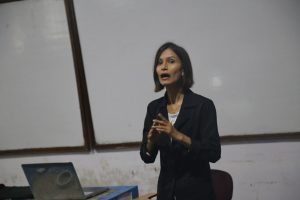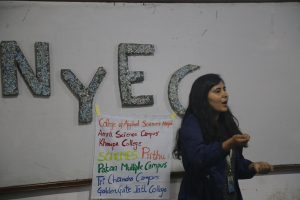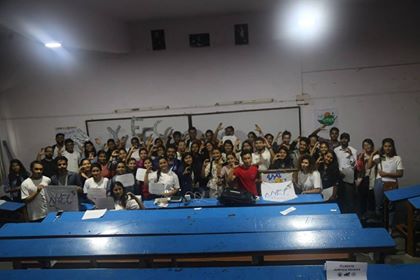Climate change has emanated as a global issue requiring urgent attention from not just world leaders but individuals from all walks of life. Considering the magnitude of this global phenomenon and the need to integrate youth in tackling the issue, Nepal Youth Environment Coalition (NYEC) with the support of CREASION and Youth Innovation on Science and Technology organised a first of its kind event on climate change. The event titled ‘Climate Interactive Tools Workshop’ was conducted for the first time in Nepal under the facilitation of Ms. Bindu Bhandari, a climate activist. Held in Amrit Science Campus (ASCOL), the event was attended by 58 students from different colleges of Kathmandu.
The event commenced with a brief welcome speech by Ms. Suvechchha Chapagain, Campaign and Communication Officer at CREASION. After a brief introduction of Ms. Bhandari, she took over the program by explaining about climate interactive tools.

Climate Interactive Tool applies Model United Nations (MUN) approach to deal with solely climate issues. Developed by Climate Interactive and MIT Sloan, it uses EnROADS simulator to allow participants to explore and rapidly assess the impacts of different solutions to address climate change. This global climate simulation model consists of 18 indicators which can be simultaneously manipulated from high, moderate to low according to the strategies proposed by different groups of delegates. The targeted outcome is controlled according to the ratings of the indicators as assigned by the delegates.
After familiarising the participants with the model and the rules of the program, the participants were divided into six groups. The six groups were identified as six different committees- World Government, Clean Technology, Conventional Energy, Climate Justice House, Land, Agriculture and Forestry and Industrial and Commercial Sector. The agenda of the program was to reduce the temperature from 4.1 degree Celsius to 2 degree Celsius as a way to combat climate change. The delegates of each group were given fifteen minutes to discuss possible ways their respective committees could do so through different policies.

With the formal speech of the Secretary – General, whose role was played by Bhandari herself, the first plenary presentations was commenced. Each team had to propose one policy to achieve the set agenda. Clean Tech committee proposed subsidizing new technology, Conventional Energy committee proposed carbon sequestration, Climate Justice House stated reducing greenhouse gas emission as their primary policy, World Government came up with the policy pertaining to the moderate carbon price, Land, Agriculture, and Forestry suggested managing deforestation and Industry and Commercial Sector proposed electrification of transportation.
At the end of the first round, the committees’ joint effort and strategies could reduce the temperature to 2.5 degree Celsius. The second round consisted of plenary presentations with a focus on negotiations and agreements. After an interesting debate between all the committees and primary negotiations between the World Government, Conventional Energy, and Land, Agriculture and Forestry committee, the policies culminated into the drop of temperature to 2 degree Celsius and the agenda of the program was finally achieved.
The event was positively received by the participants and the energy and enthusiasm through which they participated in the entire discussion was proof to that. Kamana Pandit, one of the participants shared “We always tend to focus on climate change as a problem but seldom focus on finding solutions to it. Today’s workshop has definitely helped me understand climate change better and made me more aware of the policy level efforts that go into combating the issue.”

The three hour – long event ended with Bhandari’s brief remarks on the program where she encouraged youth to constantly update themselves about the issues of climate change and deal with the problem not just through logic and emotions but through scientific facts.







